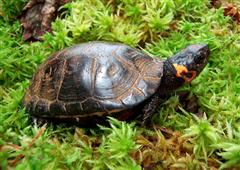Bog Turtle
Scientific Name: Clemmys muhlenbergi
Sun, 24th November, 2024 - 11:55 pm GMT
Sponsor Ads:

Alternative Name
Scientific Name: Clemmys muhlenbergiBasic Info
Bog Turtles attain an average shell length of 3 inches (8 cm), but can grow up to a little over 4 inches (11 cm). The Bog Turtle can be identified by its bright yellow or orange chin and throat. The shell is dome shaped on the bottom and oblong from the top. The speckled upper shell is dark with light streaks. The yellow lower shell has symmetrical dark spots.
Health
Breeding Bog Turtles reproduce between late April and early June, after they stop hibernating. They build nests in a compact tuft of grass or on moss in the sun. Two to five eggs are laid between June and July and develop and hatch on their own. The eggs usually hatch between July and September, about seven or eight weeks after being laid. They may sometimes over-winter in the nest and hatch the following spring, when food is more readily available. The young have a very high mortality rate, as they are only an inch long and are often eaten by birds and other animals. The eggs are often preyed upon by skunks and raccoons.Habitat
Their habitat must be calcareous, meaning it contains calciumBehavior
The Bog Turtle is a moderately sized turtle, although it is the smallest of all the turtles found in Connecticut. It is native to the northern United States. They are very interesting animals, in both appearance and behavior. Usually quite timid, if threatened, the Bog Turtle prefers to dive into the water where it can remain for hours. However, if they cannot get to water they will hide in their shell and snap. The Bog Turtle resides in weedy, swampy areas in the northern United States.. They are thought to live around 40 years in the wild. In the winter, the Bog Turtle hibernates under about six to eighteen inches of mud. They prefer areas of high humidity where they can get plenty of sunlight.Origin
North AmericaHistory
The Bog Turtle is the rarest turtle in Connecticut. They also reside in western Massachusetts and throughout New York, Maryland, Virginia, North Carolina, Georgia, and near the Great Lakes. They are quite rare in all of their habitats and are considered a threatened animal. The reason for their decline is most likely the development, in the form of draining and filling many of the turtle's native bogs. The remaining wetlands are separate from each other, meaning the turtles are farther apart than they once were. Therefore, the turtles can only breed within their own population, which results in a much smaller set of genetic variables, reducing the turtle's ability to adapt to the changing environment. In 1973, the Convention on International Trade in Endangered Species gave the Bog Turtle protection.Common Foods
They feed on berries, seeds, worms, slugs, and insects, as well as on crayfish, snakes, snails, frogs, and carrion. They are often preyed upon by skunks and raccoons, especially when young.Sponsor Ads:
"He who knows these things, and in fighting puts his knowledge into practice, will win his battles. He who knows them not, nor practices them, will surely be defeated." -- Sun Tzu, The Art of War
Bog Turtle
Coded by: BGID® | ALL RIGHTS RESERVED Copyright © 2000-2024
Disclaimer | Privacy | Report Errors / Contact | Credits
















